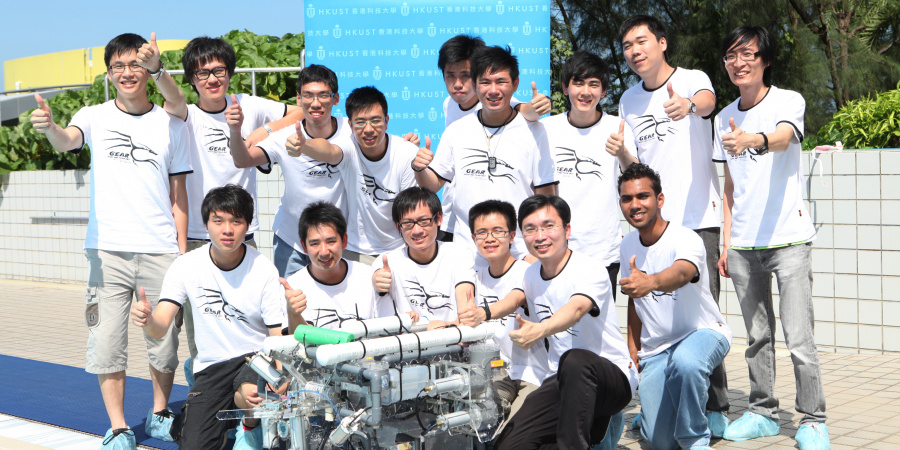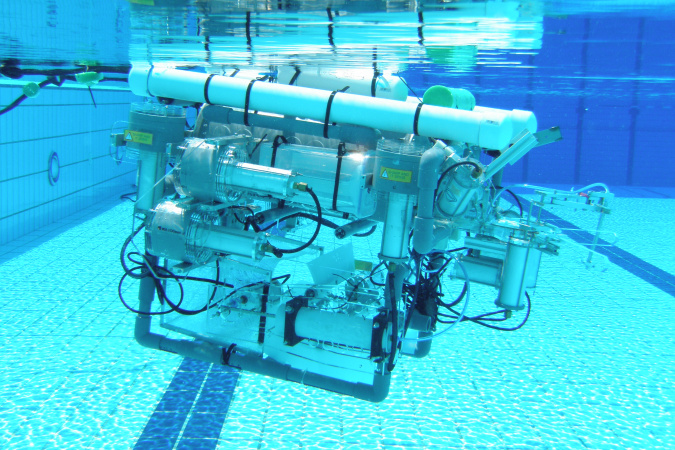HKUST Students Win Design Elegance Award in international ROV Competition at NASA
A team of undergraduate students from the School of Engineering of the Hong Kong University of Science and Technology (HKUST) has won the Design Elegance Award in their very first attempt at the 2011 International Student Remotely Operated Vehicle Competition (ROV).
The three-day competition was held at NASA’s Neutral Buoyancy Laboratory in Houston, USA, in mid June. This year, 26 teams of higher education students from seven countries participated. Under the simulation of oil spill scenario in the Gulf of Mexico, teams were required to design underwater robots, known as remotely operated vehicles (ROVs), to execute various tasks at a depth of over ten meters under water, such as collecting water samples, capping a wellhead and rescuing animals. Teams also had to introduce their ROVs to a panel of judges through presentation of posters. Team members were tested on both their ability to communicate what they learned and how they put their knowledge to use.
The ‘GEAR’ team of HKUST consisted of 13 engineering students from various disciplines - mechanical engineering, electronic and computer engineering, as well as computer science and engineering. By integrating different fields of expertise, they designed and produced their customized ROV. The team advanced to the finals after winning the regional championship in Hong Kong in April.
The award-winning ROV created by the ‘GEAR’ team was appraised by the judges as “incorporating aesthetics, simplicity, and functionality into one pursuit”. The concept of the design was inspired by toy model-building bricks, where the body of the minifigures can be connected with tools like wrench, camera, to fulfill the needs of real-world ocean workplace. The design not only enhances the efficiency in accomplishing various tasks, but also in carrying out targeted reparation for malfunctioning components, the machine can be fixed within five minutes. The design also incorporates the use of a ‘dancing mode’ structured with a self-developed propeller, making the ROV capable of 360-degree rotations, whereas conventional robotic designs only allow movement of up to 180-degrees.
HKUST’s ‘GEAR’ team owes its success to its members remaining calm and responsive when faced with unpredictable challenges, including the sudden change in water depth from 10 to 13 meters, thereby increasing the water pressure and possibly affecting how the ROV functions.
The ‘GEAR’ team was led by Prof Tim Woo of HKUST’s Department of Electronic & Computer Engineering. Prof Woo said that, by encouraging students to participate in international competitions, students can apply what they have learnt in class, and more importantly, preparing them for their future through sharpening their creativity, communication skills and critical thinking, in line with HKUST’s commitment in nurturing all-rounded global leaders.
Organized by the Marine Advanced Technology Education (MATE), the ROV competition aims to increase student and educator awareness of marine technical fields and has been an important platform for connecting students and educators with marine technology employers and professionals. Each year, the competition attracts hundreds of higher education students from across the globe, including USA, Japan and Hong Kong.


